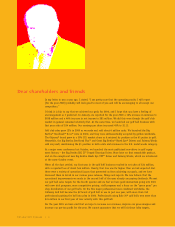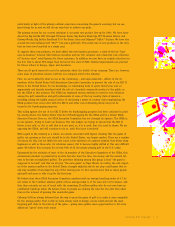Callaway 2000 Annual Report Download - page 19
Download and view the complete annual report
Please find page 19 of the 2000 Callaway annual report below. You can navigate through the pages in the report by either clicking on the pages listed below, or by using the keyword search tool below to find specific information within the annual report.
Callaway Golf Company | 19
MANAGEMENT’SDISCUSSION AND ANALYSIS OF FINANCIAL CONDITION AND RESULTS OF OPERATIONS
RESULTS OF OPERATIONS
Years Ended December 31, 2000 and 1999
For the year ended December 31, 2000, net sales increased $118.6
million, or 16%, to $837.6 million from $719.0 million in the prior
year. The increase is attributable to an increase in sales of irons,
golf balls and other products, including putters and accessories,
partially offset by a decrease in sales of metal woods. The increase
in sales of irons of 40% to $310.2 million represents an increase
in both unit and dollar sales and is primarily attributable to sales
of Great Big Bertha® Hawk Eye® Tungsten InjectedTM Titanium
Irons, which were not sold in significant quantities during 1999.
Also contributing to the increase in sales of irons were sales of Big
Bertha® SteelheadTM X-14® Stainless Steel Irons, which were intro-
duced in January 2000, and which generated higher revenues dur-
ing 2000 than its predecessor, Big Bertha® SteelheadTM X-12®
Stainless Steel Irons, did in 1999. This increase includes sales of
$34.0 million of its Rule 35® golf balls during 2000. This product
was not sold during 1999. The overall decrease in sales of metal
woods of 3% to $416.2 million represents a decrease in both unit
and dollar sales of titanium and non-current metal woods, par-
tially offset by an increase in unit and dollar sales of stainless
steel metal woods. The overall decrease in sales of metal woods is
primarily attributable to sales of non-current products during
1999, which did not occur in significant quantities during the
comparable period of 2000, and to a decrease in sales of Great Big
Bertha® Hawk Eye® Titanium Metal Woods during 2000 as com-
pared with 1999, the year in which they were introduced.
However, sales of ERCTM Forged Titanium Drivers, which began
shipping in significant quantities in the second quarter of 2000,
and initial shipments of the Company’s newly-introduced ERC IITM
Forged Titanium Drivers and Big Bertha® Hawk Eye® VFTTM
Titanium Metal Woods, which began shipping in limited quantities
in December 2000, partially offset the decrease in sales of tita-
nium metal woods. Also partially offsetting the decrease in sales
of titanium metal woods was an increase in sales of stainless steel
metal woods attributable to the January 2000 introduction of Big
Bertha® Steelhead PlusTM Stainless Steel Metal Woods, which gen-
erated higher revenue in 2000 than their predecessor, Big Bertha®
SteelheadTM Stainless Steel Metal Woods, did in 1999.
Net sales reflect the effect of a reclassification of shipping rev-
enues from selling expenses. This reclassification, which added $5.5
million to net sales in 2000 and $4.6 million in 1999 was required
by Emerging Issues Task Force Issue No. 00-10 (“EITF 00-10”), and
did not result in a change in the Company’s earnings or earnings
per share for any period.
During 2000, sales increased in all regions as compared with
1999. Sales in the United States increased 8% to $451.2 million
and sales in Europe also increased 9% to $125.5 million. Sales in
Japan increased 118% to $122.0 million largely because the Com-
pany now sells directly to customers rather than through a dis-
tributor, as in prior years. Sales in the rest of Asia increased 13%
to $82.3 million and sales in the rest of the world increased 1% to
$56.5 million.
For the year ended December 31, 2000, cost of goods sold
increased to $440.1 million from $384.3 million in 1999, and as a
percentage of net sales remained constant at 53%. These amounts
reflect the reclassification of shipping expense from “selling”
expense that resulted from the application of EITF 00-10. This
reclassification added $11.2 million to cost of goods sold during
2000 and $7.9 million in 1999. Cost of goods sold was adversely
affected in 2000 by costs associated with manufacturing the
Company’s new golf balls, primarily from low plant utilization and
production yields. This effect was offset by improvements in cost
of goods sold attributable to golf club products. As a percentage
of net sales, cost of goods sold for golf club products improved to
49% in 2000 from 53% in 1999. This improvement is attributable
to reductions in manufacturing labor and overhead expenses, a
favorable product sales mix primarily related to sales of ERCTM
Forged Titanium Drivers and the negative effect that close-out
sales at substantially reduced prices during 1999 had on that peri-
od’s cost of goods sold as a percentage of net sales.
Selling expense in 2000 increased to $170.5 million from
$128.6 million in 1999, and as a percentage of net sales
increased to 20% from 18%. These amounts include the reclassi-
fication of shipping revenue and expense, which were previously
recorded in “selling” expense. The effect of this reclassification
reduced selling expense by $5.7 million in 2000 and $3.3 million
in 1999. The overall increase in selling expense was primarily
attributable to incremental expenses associated with the launch
of the Company’s Rule 35® golf balls and with expanded golf club
sales activity in the Company’s Japanese subsidiary. Prior to
2000, Callaway Golf products were sold in Japan through a third
party distributor. Expenses related to product endorsement also
contributed to the increase.
General and administrative expense decreased to $70.3 million
in 2000 from $92.5 million in 1999, and as a percentage of net
sales decreased to 8% from 13%. This decrease is primarily attrib-
utable to the shifting of costs associated with the Company’s golf
ball pre-production period from general and administrative
expense in 1999 to cost of goods sold in 2000, as these costs were
























